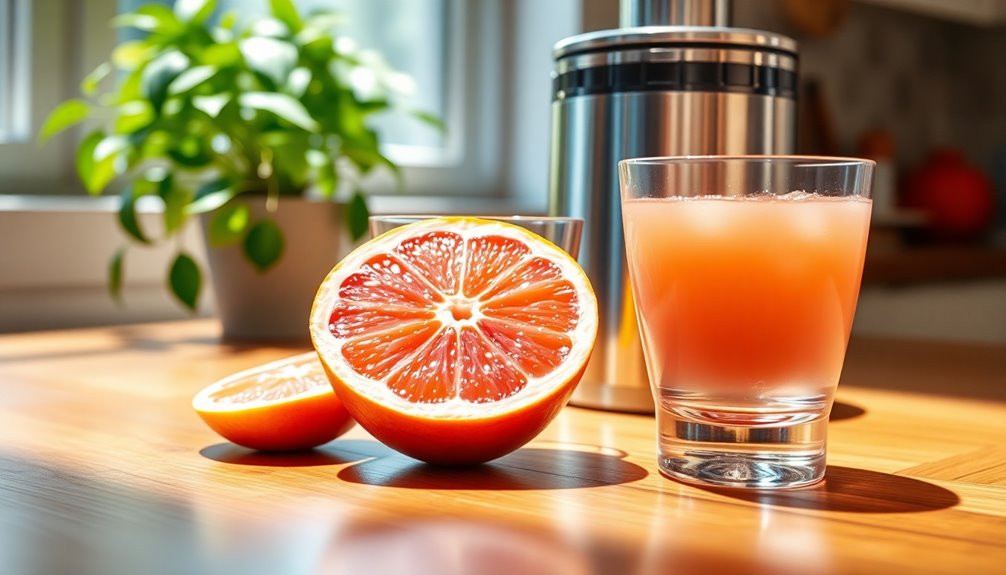To juice a grapefruit, start by peeling and chopping the fruit. Remove the white pith and seeds to reduce bitterness. You can use a handy juicer or a hand-held option for a personal touch. For a smoother juice, blend the pieces with a little water and strain the mixture. Sweeten it with honey or syrup if the tartness is too strong. Enjoy the refreshing juice on its own or mixed with cocktails; there's always more to explore!
Key Takeaways
- Peel and chop the grapefruit to make juicing easier and avoid bitterness from the white pith and seeds.
- Use a handy juicer or a hand-held juicer for minimal effort and maximum juice extraction.
- If blending, combine chopped grapefruit with a little water, then strain through a fine mesh sieve for smooth juice.
- For those who find the tartness overwhelming, add honey or syrup to sweeten the juice to taste.
- Store freshly squeezed juice in the refrigerator for 2-3 days, or freeze in ice cube trays for up to 6 months.

Juicing a grapefruit is a simple, refreshing way to enjoy its tangy flavor and health benefits. Grapefruit is packed with vitamin C, which helps boost your immune system, and it's known for its anti-inflammatory properties. Plus, making homemade grapefruit juice is a great way to kickstart your day or add a zesty touch to your meals. Let's dive into how you can easily make grapefruit juice at home.
To start, you'll need a ripe grapefruit. Slice it in half and decide on your juicing method. If you have a handy juicer, you can peel and chop the grapefruit into smaller pieces before putting it in the machine. This method usually yields plenty of juice with minimal effort. The key is to remove the white pith and seeds, as they can add a bitter taste to your juice.
If you prefer a more hands-on approach, grab a hand-held juicer or even a ramekin. Just press the half-grapefruit against the juicer and twist; you'll be amazed at how much juice you can extract this way.
If you want a smoother texture, using a blender is another great option. For this method, start by peeling and chopping the grapefruit, then blend it with a little water until it's completely smooth. After blending, strain the mixture through a fine mesh sieve or cheesecloth to remove any pulp. This will give you a clear, refreshing juice that's perfect for sipping or mixing into cocktails.
Sometimes, the natural tartness of grapefruit can be a bit overwhelming, especially if you're not used to it. If that's the case, consider adding a touch of sweetness. A little honey or syrup can balance out the flavors nicely, making your homemade grapefruit juice even more enjoyable. Just remember to mix it well to ensure the sweetener is evenly distributed.
Once you've made your delicious grapefruit juice, you might wonder how to store it. Freshly squeezed juice can be kept in the refrigerator for 2-3 days. If you want to extend its shelf life, you can freeze grapefruit juice in ice cube trays. This way, you can freeze grapefruit juice for up to 4-6 months without losing its nutritional benefits. Just pop out a few cubes whenever you want a quick refreshment or to enhance your smoothies.
Incorporating grapefruit juice into your diet can be a flavorful way to enjoy its numerous health benefits. With its rich vitamin C content and anti-inflammatory properties, it's a fantastic addition to your daily routine. So give it a try! Juicing grapefruit isn't just easy, it's also a delicious way to boost your health.
Frequently Asked Questions
How Do You Juice a Grapefruit Without a Juicer?
To juice a grapefruit without a juicer, start by cutting the fruit in half.
Place one half cut side down on a surface, then press and twist it to extract the juice.
For more juice, you can smash the segments with a ramekin and squeeze them to release every drop.
Once you've got the juice, strain it through a fine mesh to remove any pulp.
Enjoy your fresh grapefruit juice right away!
Can You Juice an Entire Grapefruit?
Have you ever wondered if you can juice an entire grapefruit? Yes, you can! Just make sure to remove the peel, white pith, and seeds to avoid bitterness.
Using a juicer or blender works best for extracting maximum juice. If you don't have a juicer, squeezing the halves directly or chopping the fruit into smaller pieces can still yield delicious results.
Enjoy a refreshing drink packed with vitamins and antioxidants!
How to Quickly Juice Grapefruit?
If you want to quickly juice grapefruit, start by cutting it in half with a sharp knife.
Use a citrus juicer, pressing and twisting each half to extract as much juice as possible.
For a hands-on method, try squeezing the grapefruit half cut side down on a small bowl, ensuring you access all the juice. This technique not only maximizes juice extraction but also minimizes the mess. However, if any juice splatters onto your countertops or clothing, don’t worry; there are effective grape juice stain removal tips to help you tackle those pesky spots. Act quickly to blot the stain gently with a clean cloth and use a mixture of dish soap and water for the best results.
Finally, strain the juice to remove any pulp, making it smooth and refreshing for your drink.
Enjoy!
How to Do a Juice Fast Without a Juicer?
You might think a juice fast requires fancy equipment, but you can absolutely do it without a juicer.
Start by choosing your favorite fruits and vegetables, then wash and chop them.
Use a blender to mix with water, and strain the mixture through a fine mesh sieve or nut milk bag.
This way, you'll enjoy fresh juice without any bitterness.
Remember to stay hydrated and listen to your body during the fast!
Conclusion
Juicing a grapefruit is like unlocking a treasure chest of flavor and health benefits. Just as each grapefruit hides its juicy gems beneath a thick rind, your efforts in the kitchen reveal refreshing rewards. You're not just quenching your thirst; you're boosting your vitamin C and energizing your day. So next time you slice into that vibrant fruit, remember: you're not just making juice—you're crafting a delicious experience that nourishes both body and spirit. Enjoy every drop!
Cindy thoroughly researches juicing trends, techniques, and recipes to provide readers with practical advice and inspiration. Her writing style is accessible, engaging, and designed to make complex concepts easy to understand. Cindy’s dedication to promoting the advantages of juicing shines through her work, empowering readers to make positive changes in their lives through the simple act of juicing.
















